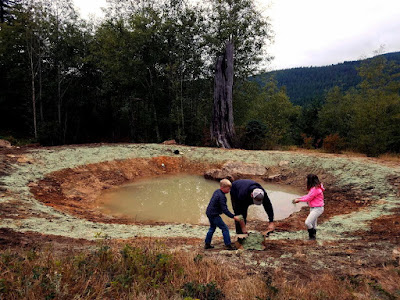9:09 am - 52 degrees outside - overcast, low clouds...
It’s
that time of year again... hunting season.
Hunting
wild animals for food used to be a part of everyday life – for some it still
is. Hunting may not be for everyone, but
it’s a part of our lives. Hunting is
simply harvesting wild food, and we only harvest what our family will eat.
 |
| my great-grandmother in the early 1900s |
Tony
hunts for deer and elk every year – one deer and one elk will put enough meat
in the freezer to feed our family for a whole year and be able to share some
with family and friends.
A few
years ago, our daughter took and passed a hunters education class to get her
hunting license. Last year she got her
first buck (male deer), and this year she got her first bull (male elk). We are very proud of her, and she is helping
to provide for our family. We are also
very proud that our children know and understand where their food comes from.
 |
| Caitlyn's first bull elk. Shot 2nd day of rifle elk season. |
Hunting
for our own food also gives us peace of mind that the meat in our freezer has
not been tainted by antibiotics, artificial hormones, pesticides, herbicides,
or unnatural feeds that are not needed and are possibly harmful.
 |
| Elk tastes similar to beef (no gamey flavor). Compared to beef, elk meat is lower in fat and higher in protein. |
There
are a lot of shocking things about meat.
Sometimes I find that the most shocking thing about meat to some people,
is that meat is actually made of dead animals!
Crazy right? Sorry for my
sarcasm, but I do seriously think we maintain a cognitive dissonance between
the animals we see and the meat we eat.
One of
the problems with our current food system is that there is this real disconnect
with where our food comes from. The same
person who would squeal if they saw a farmer shoot a cow can easily buy
packages of ground beef at the grocery store...or a package of skinless,
boneless chicken breasts...or fish fillets.
While we understand what meat is in a cerebral way, we don’t really
understand what that means. We don’t
equate a dead, bleeding animal with this delicious looking meal on our
plate. We literally and figuratively
remove the life from our food.
To
hunt and butcher an animal is to recognize that meat is not some abstract form
of protein that springs into existence at the grocery store tightly wrapped in
cellophane and styrofoam. Meat is
life. It still astounds me how many
people actually believe that the meat they buy at the grocery store...is just
meat at the grocery store. They forget
or choose to forget where it really came from – a living breathing animal. In order to appreciate that slice of steak on
your plate, I think you need to also know and appreciate where it came from.




























































